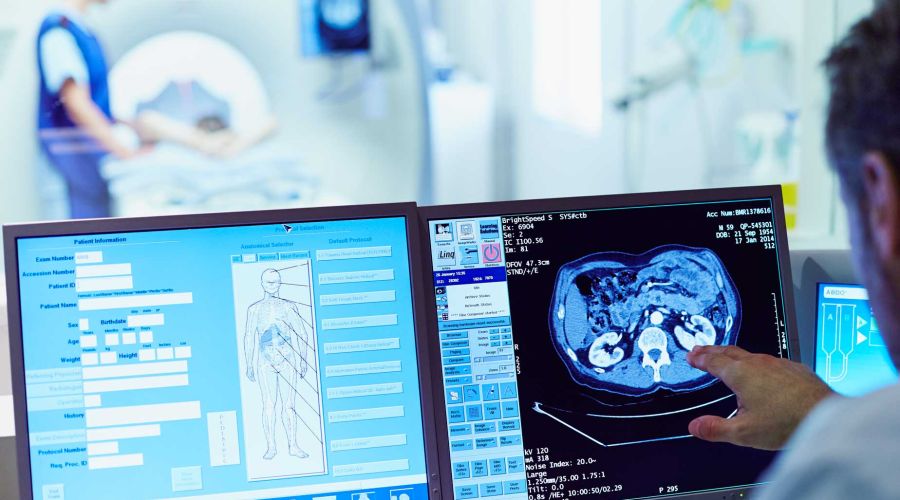Imaging techniques
AMICE harbors a wide range of state-of-the-art preclinical imaging equipment and expertise.

Preclinical Imaging Techniques provide researchers with a wide range of tools to study biological processes in preclinical models. Each technique has unique advantages and limitations, depending on the tissues or functions being investigated. In preclinical research, these methods are often used complementarily to obtain both anatomical and functional data. Below is an overview of imaging techniques available within AMICE.
Bioluminescence Imaging
-
How it works
Bioluminescence imaging uses enzymes that emit light when reacting with a specific substrate. By introducing bioluminescent cells or organisms, the emitted light can be detected.
-
Application
This technique is widely used in preclinical studies to track tumor growth, infections, and gene expression in living animals. Bioluminescence is highly sensitive and can detect small amounts of light, but it is mainly effective for monitoring processes in superficial tissues.
-
Available in centers
-
Showcases
Click on the button below for an oversight of showcases with this technique
Fluorescence Imaging
-
How it works
Fluorescence imaging uses fluorescently labeled molecules that absorb light at a specific wavelength and re-emit it at a longer wavelength. This fluorescence is detected by a camera, allowing the localization of specific molecules or cells in the body.
-
Application
Fluorescence imaging is often used to track specific biological processes, such as tumor growth or the migration of immune cells. It is especially useful for surface imaging, although certain techniques allow imaging of deeper tissues as well.
-
Available in centers
-
Showcases
Click on the button below for an oversight of showcases with this technique
Photoacoustics
-
How it works
Photoacoustics combines light and sound. When laser light is directed at tissue, some molecules absorb the light, causing thermoelastic expansion and the generation of ultrasound waves. These waves are detected and converted into images.
-
Application
This technique is used for deep tissue imaging, commonly for studying blood oxygenation levels and vascular structures. It provides both functional and anatomical information and is used in oncological and cardiovascular research.
-
Available in centers
-
Showcases
Click on the button below for an oversight of showcases with this technique
Ultrasound
-
How it works
Ultrasound uses high-frequency sound waves that are reflected by tissues in the body. These reflected waves are captured by a transducer and converted into images of internal structures.
-
Application
It is often used to image soft tissues such as the heart, liver, or embryos. In preclinical studies, ultrasound is a fast, non-invasive method to visualize anatomical changes and blood flow.
-
Available in centers
-
RadboudUMC
-
UMCU
-
AMC
-
ErasmusMC
Vevo3100 - VisualSonics
-
-
Showcases
Click on the button below for an oversight of showcases with this technique
Micro-Computed Tomography (µCT)
-
How it works
µCT is the preclinical version of CT-scans, using X-rays to create cross-sectional images of the body. By scanning the body from different angles, detailed 3D images are generated.
-
Application
µCT provides high spatial resolution and is commonly used for imaging bone structures or lungs. It can also visualize vasculature or monitor changes in tissue structure in preclinical studies.
-
Available in centers
-
Showcases
Click on the button below for an oversight of showcases with this technique
Positron Emission Tomography (PET)
-
How it works
PET is similar to SPECT, but it uses positron-emitting radiopharmaceuticals. When these positrons collide with electrons in the body, photons (gamma rays) are produced and detected.
-
Application
PET is mainly used to image metabolic processes, such as glucose metabolism or protein synthesis. This is highly useful in oncology, neurological, and cardiovascular preclinical studies. PET offers higher sensitivity than SPECT but is often more expensive.
-
Available in centers
-
UMCG
-
RadboudUMC
-
ErasmusMC
VECTor5 - MILabs
-
-
Showcases
Click on the button below for an oversight of showcases with this technique
Single Photon Emission Computed Tomography (SPECT)
-
How it works
In SPECT, radioactive substances (radiopharmaceuticals) are injected, which emit gamma rays. These gamma rays are detected by a gammacamera, and a 3D image of the radioactive substance distribution in the body is reconstructed.
-
Application
SPECT is often used to visualize blood flow to organs such as the heart and brain. It provides functional information on physiological processes and is useful for studying cancer cells or metabolism in preclinical studies.
-
Available in centers
-
UMCG
-
RadboudUMC
-
AMC
-
LUMC
-
ErasmusMC
VECTor5 - MILabs
SPECT/MRI - Mediso
-
-
Showcases
Click on the button below for an oversight of showcases with this technique
Magnetic Resonance Imaging (MRI)
-
How it works
MRI uses a strong magnetic field and radio waves to create detailed images of tissues and organs. Water molecules in the body respond to the magnetic field, and by measuring these responses, a detailed image can be formed.
-
Application
MRI provides excellent resolution for mapping soft tissues such as the brain, muscles, and organs. It is often used to study tumors, brain disorders, and cardiovascular abnormalities in preclinical research. A key advantage is that it does not use ionizing radiation, making it suitable for longitudinal studies.
-
Available in centers
-
Showcases
Click on the button below for an oversight of showcases with this technique
